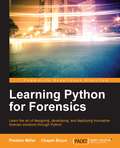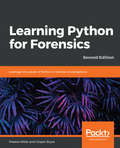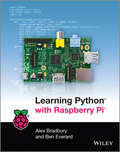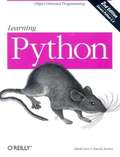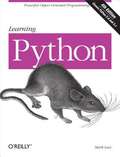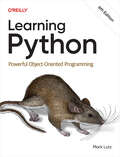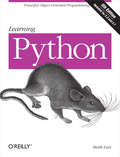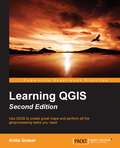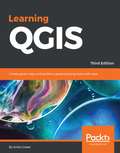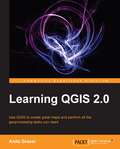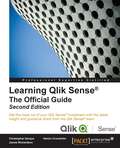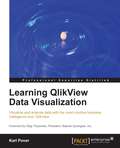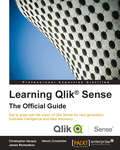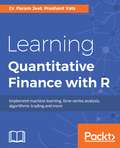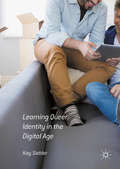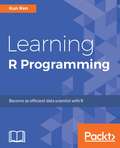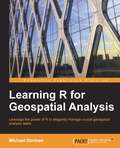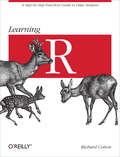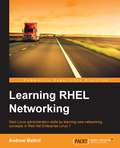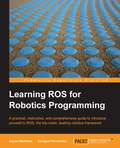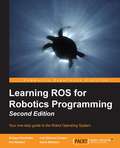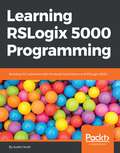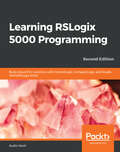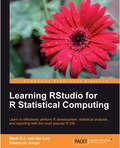- Table View
- List View
Learning Python for Forensics
by Preston Miller Chapin BryceLearn the art of designing, developing, and deploying innovative forensic solutions through Python About This Book * This practical guide will help you solve forensic dilemmas through the development of Python scripts * Analyze Python scripts to extract metadata and investigate forensic artifacts * Master the skills of parsing complex data structures by taking advantage of Python libraries Who This Book Is For If you are a forensics student, hobbyist, or professional that is seeking to increase your understanding in forensics through the use of a programming language, then this book is for you. You are not required to have previous experience in programming to learn and master the content within this book. This material, created by forensic professionals, was written with a unique perspective and understanding of examiners who wish to learn programming What You Will Learn * Discover how to perform Python script development * Update yourself by learning the best practices in forensic programming * Build scripts through an iterative design * Explore the rapid development of specialized scripts * Understand how to leverage forensic libraries developed by the community * Design flexibly to accommodate present and future hurdles * Conduct effective and efficient investigations through programmatic pre-analysis * Discover how to transform raw data into customized reports and visualizations In Detail This book will illustrate how and why you should learn Python to strengthen your analysis skills and efficiency as you creatively solve real-world problems through instruction-based tutorials. The tutorials use an interactive design, giving you experience of the development process so you gain a better understanding of what it means to be a forensic developer. Each chapter walks you through a forensic artifact and one or more methods to analyze the evidence. It also provides reasons why one method may be advantageous over another. We cover common digital forensics and incident response scenarios, with scripts that can be used to tackle case work in the field. Using built-in and community-sourced libraries, you will improve your problem solving skills with the addition of the Python scripting language. In addition, we provide resources for further exploration of each script so you can understand what further purposes Python can serve. With this knowledge, you can rapidly develop and deploy solutions to identify critical information and fine-tune your skill set as an examiner. Style and approach The book begins by instructing you on the basics of Python, followed by chapters that include scripts targeted for forensic casework. Each script is described step by step at an introductory level, providing gradual growth to demonstrate the available functionalities of Python.
Learning Python for Forensics - Second Edition: Leverage the power of Python in forensic investigations, 2nd Edition
by Preston Miller Chapin BryceIf you are a forensics student, hobbyist, or professional that is seeking to increase your understanding in forensics through the use of a programming language, then this book is for you. You are not required to have previous experience in programming to learn and master the content within this book. This material, created by forensic professionals, was written with a unique perspective and understanding of examiners who wish to learn programming
Learning Python with Raspberry Pi
by Alex Bradbury Ben EverardThe must-have companion guide to the Raspberry Pi User Guide!Raspberry Pi chose Python as its teaching language of choice to encourage a new generation of programmers to learn how to program. This approachable book serves as an ideal resource for anyone wanting to use Raspberry Pi to learn to program and helps you get started with the Python programming language. Aimed at first-time developers with no prior programming language assumed, this beginner book gets you up and running.Covers variables, loops, and functionsAddresses 3D graphics programmingWalks you through programming MinecraftZeroes in on Python for scriptingLearning Python with Raspberry Pi proves itself to be a fantastic introduction to coding.
Learning Python, 2nd Edition
by David Ascher Mark LutzLearning Python , Second Edition offers programmers a comprehensive learning tool for Python and object-oriented programming. Thoroughly updated, this guide introduces the basic elements of the latest release of Python 2.3 and covers new features, such as list comprehensions, nested scopes, and iterators/generators.
Learning Python, 3rd Edition
by Mark LutzPortable, powerful, and a breeze to use, Python is ideal for both standalone programs and scripting applications. With this hands-on book, you can master the fundamentals of the core Python language quickly and efficiently, whether you're new to programming or just new to Python. Once you finish, you will know enough about the language to use it in any application domain you choose. Learning Python is based on material from author Mark Lutz's popular training courses, which he's taught over the past decade. Each chapter is a self-contained lesson that helps you thoroughly understand a key component of Python before you continue. Along with plenty of annotated examples, illustrations, and chapter summaries, every chapter also contains Brain Builder, a unique section with practical exercises and review quizzes that let you practice new skills and test your understanding as you go. This book covers: Types and Operations -- Python's major built-in object types in depth: numbers, lists, dictionaries, and more Statements and Syntax -- the code you type to create and process objects in Python, along with Python's general syntax model Functions -- Python's basic procedural tool for structuring and reusing code Modules -- packages of statements, functions, and other tools organized into larger components Classes and OOP -- Python's optional object-oriented programming tool for structuring code for customization and reuse Exceptions and Tools -- exception handling model and statements, plus a look at development tools for writing larger programs. Learning Python gives you a deep and complete understanding of the language that will help you comprehend any application-level examples of Python that you later encounter. If you're ready to discover what Google and YouTube see in Python, this book is the best way to get started.
Learning Python, 4th Edition
by Mark LutzGoogle and YouTube use Python because it's highly adaptable, easy to maintain, and allows for rapid development. If you want to write high-quality, efficient code that's easily integrated with other languages and tools, this hands-on book will help you be productive with Python quickly -- whether you're new to programming or just new to Python. It's an easy-to-follow self-paced tutorial, based on author and Python expert Mark Lutz's popular training course. Each chapter contains a stand-alone lesson on a key component of the language, and includes a unique Test Your Knowledge section with practical exercises and quizzes, so you can practice new skills and test your understanding as you go. You'll find lots of annotated examples and illustrations to help you get started with Python 3.0. Learn about Python's major built-in object types, such as numbers, lists, and dictionaries Create and process objects using Python statements, and learn Python's general syntax model Structure and reuse code using functions, Python's basic procedural tool Learn about Python modules: packages of statements, functions, and other tools, organized into larger components Discover Python's object-oriented programming tool for structuring code Learn about the exception-handling model, and development tools for writing larger programs Explore advanced Python tools including decorators, descriptors, metaclasses, and Unicode processing
Learning Python: Powerful Object-Oriented Programming
by Mark LutzGet a comprehensive, in-depth introduction to the core Python language with this hands-on book. Based on author Mark Lutz's popular training course, this updated sixth edition will help you quickly write efficient, high-quality code with Python. It's an ideal way to begin, whether you're new to programming or a professional developer versed in other languages. Complete with quizzes, exercises, and helpful illustrations, this easy-to-follow self-paced tutorial gets you started with Python 3.12 and all other releases in use today. With a pragmatic focus on what you need to know, it also introduces some advanced language features that have become increasingly common in Python code. This book helps you: Explore Python's built-in object types such as strings, lists, dictionaries, and files Create and process objects with Python statements, and learn Python's syntax model Use functions and functional programming to avoid redundancy and maximize reuse Organize code into larger components with modules and packages Code robust programs with Python's exception handling and development tools Apply object-oriented programming and classes to make code customizable Survey advanced Python tools including decorators, descriptors, and metaclasses Write idiomatic Python code that runs portably across a wide variety of platforms
Learning Python: Powerful Object-Oriented Programming (Animal Guide Ser.)
by Mark LutzGet a comprehensive, in-depth introduction to the core Python language with this hands-on book. Based on author Mark Lutz’s popular training course, this updated fifth edition will help you quickly write efficient, high-quality code with Python. It’s an ideal way to begin, whether you’re new to programming or a professional developer versed in other languages.Complete with quizzes, exercises, and helpful illustrations, this easy-to-follow, self-paced tutorial gets you started with both Python 2.7 and 3.3— the latest releases in the 3.X and 2.X lines—plus all other releases in common use today. You’ll also learn some advanced language features that recently have become more common in Python code.Explore Python’s major built-in object types such as numbers, lists, and dictionariesCreate and process objects with Python statements, and learn Python’s general syntax modelUse functions to avoid code redundancy and package code for reuseOrganize statements, functions, and other tools into larger components with modulesDive into classes: Python’s object-oriented programming tool for structuring codeWrite large programs with Python’s exception-handling model and development toolsLearn advanced Python tools, including decorators, descriptors, metaclasses, and Unicode processing
Learning QGIS - Second Edition
by Anita GraserThis book is great for users, developers, and consultants who know the basic functions and processes of GIS but want to learn to use QGIS to analyze geospatial data and create rich mapping applications. If you want to take advantage of the wide range of functionalities that QGIS offers, then this is the book for you.
Learning QGIS - Third Edition
by Anita GraserThe latest guide to using QGIS 2.14 to create great maps and perform geoprocessing tasks with ease About This Book * Learn how to work with various data and create beautiful maps using this easy-to-follow guide. * Give a touch of professionalism to your maps both for functionality and look and feel with the help of this practical guide. * A progressive hands-on guide that builds on a geo-spatial data and adds more reactive maps by using geometry tools. Who This Book Is For This book is great for users, developers, and consultants who know the basic functions and processes of GIS and want to learn to use QGIS to analyze geospatial data and create rich mapping applications. If you want to take advantage of the wide range of functionalities that QGIS offers, then this is the book for you. What You Will Learn * Install QGIS and get familiar with the user interface * Load vector and raster data from files, databases, and web services * Create, visualize, and edit spatial data * Perform geoprocessing tasks and automate them * Create advanced cartographic outputs * Design great print maps * Expand QGIS using Python In Detail QGIS is a user-friendly open source geographic information system (GIS) that runs on Linux, Unix, Mac OS X, and Windows. The popularity of open source geographic information systems and QGIS in particular has been growing rapidly over the last few years. Learning QGIS Third Edition is a practical, hands-on guide updated for QGIS 2.14 that provides you with clear, step-by-step exercises to help you apply your GIS knowledge to QGIS. Through clear, practical exercises, this book will introduce you to working with QGIS quickly and painlessly. This book takes you from installing and configuring QGIS to handling spatial data to creating great maps. You will learn how to load and visualize existing spatial data and create data from scratch. You will get to know important plugins, perform common geoprocessing and spatial analysis tasks and automate them with Processing. We will cover how to achieve great cartographic output and print maps. Finally, you will learn how to extend QGIS using Python and even create your own plugin. Style and approach A step by step approach to explain concepts of Geospatial map with the help of real life examples
Learning QGIS 2.0
by Anita GraserA short book with a lot of hands-on examples to help you learn in a practical way.This book is great for users, developers, and consultants who know the basic functions and processes of a GIS but want to know how to use QGIS to achieve the results they are used to a full-fledged GIS.
Learning Qlik Sense®: The Official Guide - Second Edition
by James Richardson Henric Cronstrom Christopher IlacquaGet the most out of your Qlik Sense investment with the latest insight and guidance direct from the Qlik Sense team About This Book * Updated with new coverage on Qlik Cloud, Qlik Sense Modeling, and Extending the Qlik Analytic Platform. * Get insider insight on Qlik Sense and its new approach to business intelligence * Explore practical demonstrations for utilizing Qlik Sense to discover data for sales, human resources, and more Who This Book Is For Learning Qlik Sense®: The Official Guide Second Edition is for anyone seeking to understand and utilize the revolutionary new approach to business intelligence offered by Qlik Sense. Familiarity with the basics of business intelligence will be helpful when picking up this book, but not essential. What You Will Learn * Understand the vision behind the creation of Qlik Sense, and the promise that data discovery offers to you and your organization * Get to grips with the life cycle of a Qlik Sense application * Load and manage your data for app creation * Visualize your data with Qlik Sense's engaging and informative graphing * Administer your Qlik Sense system and monitor its security * Build efficient and responsive Associative Models * Extend the Qlik Analytic Platform with the Dev Hub * Optimize Qlik Sense for sales, human resources, and demographic data discovery In Detail The intuitive and powerful Qlik Sense visual analytics software allows anyone to engage in data discovery, to explore your data, and find meaningful insights to empower your business. Qlik Sense lets you easily create personalized reports and visualizations and reveal essential connections to show new opportunities from every angle. Written by members of the Qlik Sense team, this book is the official guide from Qlik to understanding and using their powerful new product with fully updated coverage to the latest features of the most modern edition of Qlik Sense. Benefit from the vision behind the development of Qlik Sense and get to grips with how Qlik Sense can empower you as a data discovery consumer. Learn how to create your own applications for Qlik Sense to customize it to meet your personal needs for business intelligence, and how to oversee and administer the Qlik Sense data architecture. Finally, explore utilizing Qlik Sense to uncover essential data, with practical examples on finding and visualizing intelligence for sales figures, human resources information, travel expense tracking, and demographic data discovery. Style and approach This book is a practical guide to understand what Qlik Sense is and how to implement it. This is an example-rich, step-by-step book to implement and optimize Qlik Sense for sales, human resources, and demographic data discovery.
Learning Qlikview Data Visualization
by Karl PoverA practical and fast-paced guide that gives you all the information you need to start developing charts from your data.Learning QlikView Data Visualization is for anybody interested in performing powerful data analysis and crafting insightful data visualization, independent of any previous knowledge of QlikView. Experience with spreadsheet software will help you understand QlikView functions.
Learning Qlik® Sense: The Official Guide
by Henric Cronstrom Christopher IlacquaLearning Qlik® Sense is for anyone seeking to understand and utilize the revolutionary new approach to business intelligence offered by Qlik Sense. Familiarity with the basics of business intelligence will be helpful when picking up this book, but not essential.
Learning Quantitative Finance with R
by Dr Param Jeet Prashant VatsImplement machine learning, time-series analysis, algorithmic trading and more About This Book • Understand the basics of R and how they can be applied in various Quantitative Finance scenarios • Learn various algorithmic trading techniques and ways to optimize them using the tools available in R. • Contain different methods to manage risk and explore trading using Machine Learning. Who This Book Is For If you want to learn how to use R to build quantitative finance models with ease, this book is for you. Analysts who want to learn R to solve their quantitative finance problems will also find this book useful. Some understanding of the basic financial concepts will be useful, though prior knowledge of R is not required. What You Will Learn • Get to know the basics of R and how to use it in the field of Quantitative Finance • Understand data processing and model building using R • Explore different types of analytical techniques such as statistical analysis, time-series analysis, predictive modeling, and econometric analysis • Build and analyze quantitative finance models using real-world examples • How real-life examples should be used to develop strategies • Performance metrics to look into before deciding upon any model • Deep dive into the vast world of machine-learning based trading • Get to grips with algorithmic trading and different ways of optimizing it • Learn about controlling risk parameters of financial instruments In Detail The role of a quantitative analyst is very challenging, yet lucrative, so there is a lot of competition for the role in top-tier organizations and investment banks. This book is your go-to resource if you want to equip yourself with the skills required to tackle any real-world problem in quantitative finance using the popular R programming language. You'll start by getting an understanding of the basics of R and its relevance in the field of quantitative finance. Once you've built this foundation, we'll dive into the practicalities of building financial models in R. This will help you have a fair understanding of the topics as well as their implementation, as the authors have presented some use cases along with examples that are easy to understand and correlate. We'll also look at risk management and optimization techniques for algorithmic trading. Finally, the book will explain some advanced concepts, such as trading using machine learning, optimizations, exotic options, and hedging. By the end of this book, you will have a firm grasp of the techniques required to implement basic quantitative finance models in R. Style and approach This book introduces you to the essentials of quantitative finance with the help of easy-to-understand, practical examples and use cases in R. Each chapter presents a specific financial concept in detail, backed with relevant theory and the implementation of a real-life example.
Learning Queer Identity in the Digital Age
by Kay SieblerThis book explores, through specific analysis of media representations, personal interviews, and historical research, how the digital environment perpetuates harmful and limiting stereotypes of queerness. Siebler argues that heteronormativity has co-opted queer representations, largely in order to sell goods, surgeries, and lifestyles, reinforcing instead of disrupting the masculine and feminine heterosexual binaries through capitalist consumption. Learning Queer Identity in the Digital Age focuses on different identity populations (gay, lesbian, transgender) and examines the theories (queer, feminist, and media theories) in conjunction with contemporary representations of each identity group. In the twenty-first century, social media, dating sites, social activist sites, and videos/films, are primary educators of social identity. For gay, lesbian, bisexual, transgendered, and transsexual peoples, these digital interactions help shape queer identities and communities.
Learning R Programming
by Kun RenBecome an efficient data scientist with R About This Book * Explore the R language from basic types and data structures to advanced topics * Learn how to tackle programming problems and explore both functional and object-oriented programming techniques * Learn how to address the core problems of programming in R and leverage the most popular packages for common tasks Who This Book Is For This is the perfect tutorial for anyone who is new to statistical programming and modeling. Anyone with basic programming and data processing skills can pick this book up to systematically learn the R programming language and crucial techniques. What You Will Learn * Explore the basic functions in R and familiarize yourself with common data structures * Work with data in R using basic functions of statistics, data mining, data visualization, root solving, and optimization * Get acquainted with R's evaluation model with environments and meta-programming techniques with symbol, call, formula, and expression * Get to grips with object-oriented programming in R: including the S3, S4, RC, and R6 systems * Access relational databases such as SQLite and non-relational databases such as MongoDB and Redis * Get to know high performance computing techniques such as parallel computing and Rcpp * Use web scraping techniques to extract information * Create RMarkdown, an interactive app with Shiny, DiagramR, interactive charts, ggvis, and more In Detail R is a high-level functional language and one of the must-know tools for data science and statistics. Powerful but complex, R can be challenging for beginners and those unfamiliar with its unique behaviors. Learning R Programming is the solution - an easy and practical way to learn R and develop a broad and consistent understanding of the language. Through hands-on examples you'll discover powerful R tools, and R best practices that will give you a deeper understanding of working with data. You'll get to grips with R's data structures and data processing techniques, as well as the most popular R packages to boost your productivity from the offset. Start with the basics of R, then dive deep into the programming techniques and paradigms to make your R code excel. Advance quickly to a deeper understanding of R's behavior as you learn common tasks including data analysis, databases, web scraping, high performance computing, and writing documents. By the end of the book, you'll be a confident R programmer adept at solving problems with the right techniques. Style and approach Developed to make learning easy and intuitive, this book comes packed with a wide variety of statistical and graphical techniques and a wealth of practical information for anyone looking to get started with this exciting and powerful language.
Learning R for Geospatial Analysis
by Michael DormanThis book is intended for anyone who wants to learn how to efficiently analyze geospatial data with R, including GIS analysts, researchers, educators, and students who work with spatial data and who are interested in expanding their capabilities through programming. The book assumes familiarity with the basic geographic information concepts (such as spatial coordinates), but no prior experience with R and/or programming is required. By focusing on R exclusively, you will not need to depend on any external software--a working installation of R is all that is necessary to begin.
Learning R: A Step-by-Step Function Guide to Data Analysis
by Richard CottonLearn how to perform data analysis with the R language and software environment, even if you have little or no programming experience. With the tutorials in this hands-on guide, youâ??ll learn how to use the essential R tools you need to know to analyze data, including data types and programming concepts.The second half of Learning R shows you real data analysis in action by covering everything from importing data to publishing your results. Each chapter in the book includes a quiz on what youâ??ve learned, and concludes with exercises, most of which involve writing R code.Write a simple R program, and discover what the language can doUse data types such as vectors, arrays, lists, data frames, and stringsExecute code conditionally or repeatedly with branches and loopsApply R add-on packages, and package your own work for othersLearn how to clean data you import from a variety of sourcesUnderstand data through visualization and summary statisticsUse statistical models to pass quantitative judgments about data and make predictionsLearn what to do when things go wrong while writing data analysis code
Learning RHEL Networking
by Andrew MallettThis book is ideal for administrators who need to learn the networking abilities of Red Hat Enterprise Linux 7. You may not be a Linux administrator already, but you will need to be able to test files in Linux and navigate the filesystem.
Learning ROS for Robotics Programming
by Enrique Fernandez Aaron MartinezThe book will take an easy-to-follow and engaging tutorial approach, providing a practical and comprehensive way to learn ROS.If you are a robotic enthusiast who wants to learn how to build and program your own robots in an easy-to-develop, maintainable and shareable way, "Learning ROS for Robotics Programming" is for you. In order to make the most of the book, you should have some C++ programming background, knowledge of GNU/Linux systems, and computer science in general. No previous background on ROS is required, since this book provides all the skills required. It is also advisable to have some background on version control systems, like svn or git, which are often used to share the code by the community.
Learning ROS for Robotics Programming - Second Edition
by Enrique Fernandez Luis Sanchez CrespoIn order to make the most of the book, you should have a C++ programming background, knowledge of GNU/Linux systems, and general skills in computer science. No previous background in ROS is required, as this book takes you from the ground up.
Learning RSLogix 5000 Programming
by Austin ScottBecome proficient in building PLC solutions in Integrated Architecture from the ground up using RSLogix 5000 About This Book * Introduction to the Logix platform and Rockwell Automation terminology, with resources available online in the literature library * Build real-world Rockwell Automation solutions using ControlLogix, CompactLogix, SoftLogix, RSLogix 5000, and Studio 5000 * Understand the various controllers and form factors available in the ControlLogix and CompactLogix platforms, and the recent changes under the new Studio 5000 Automation Engineering and Design software suite Who This Book Is For This book is for PLC programmers, electricians, instrumentation techs, automation professionals with basic PLC programming knowledge, but no knowledge of RSLogix 5000. If you are a student who is familiar with automation and would like to learn about RSLogix 5000 with minimal investment of time, this is the book for you. What You Will Learn * Briefly explore the history of Rockwell Automation and the evolution of the Logix platform * Discover the complete range of ControlLogix and ComplactLogix controllers and form factors available today, and the key things you should consider when you are engineering a Rockwell Automation solution * Explore the key platform changes introduced with Studio 5000 and Logix Designer version 24 and the latest firmware versions * Get to grips with the modules available in the ControLogix, SoftLogix, and CompactLogix platforms * Understand writing Ladder Logic (LL) routines, Sequential Function Chart (SFC) routines, and Structured Text routines (ST) * Design Function Block Diagrams (FBD) and their easy integration with HMIs In Detail RSLogix 5000 and Studio 5000's Logix Designer are user-friendly interfaces used for programming the current generation of Rockwell Automation Controllers including ControlLogix, CompactLogix, and SoftLogix. When engineering automation solutions using Logix, it is important to study the changes to the platform introduced with Studio 5000 and the various controllers, modules, and form factors available today. RSLogix 5000 programming packages help you maximize performance, save project development time, and improve productivity. This book provides a detailed overview of the Logix platform including ControlLogix, CompactLogix, and SoftLogix and explains the significant changes introduced in Studio 5000. A clear understanding of the recent Logix platform changes is critical for anyone developing a Rockwell Automation solution. It provides an easy-to-follow, step-by-step approach to learning the essential Logix hardware and software components and provides beginners with a solid foundation in the Logix platform features and terminology. By the end of this book, you will have a clear understanding of the capabilities of the Logix platform and the ability to navigate the Rockwell Automation Literature Library Resources. Style and approach A step-by-step approach to RSLogix 5000, which is explained in an easy-to-follow style. Each topic is explained sequentially with detailed explanations of the basic and advanced features of Rockwell Automation that appeal to the needs of readers with a wide range of experience.
Learning RSLogix 5000 Programming: Build robust PLC solutions with ControlLogix, CompactLogix, and Studio 5000/RSLogix 5000, 2nd Edition
by Austin ScottGet to grips with the Logix platform, Rockwell Automation terminologies, and the online resources available in the Literature Library Key Features Build real-world solutions using ControlLogix, CompactLogix, and RSLogix 5000/Studio 5000 Understand the different controllers and form factors offered by the ControlLogix and CompactLogix platforms Explore the latest changes in the Studio 5000 Automation Engineering and Design software suite Book Description Understanding programmable logic controller (PLC) programming with Rockwell Software's Logix Designer and the Studio 5000 platform, which includes ControlLogix, CompactLogix, and SoftLogix, is key to building robust PLC solutions. RSLogix 5000/Studio 5000's Logix Designer are user-friendly IEC 61131-3-compliant interfaces for programming the current generation of Rockwell Automation Controllers using Ladder Diagram (LD), Function Block Diagram (FBD), Structured Text (ST), and Sequential Function Chart (SFC). This second edition of Learning RSLogix 5000 Programming guides you through the technicalities and comes packed with the latest features of Studio 5000, industrial networking fundamentals, and industrial cybersecurity best practices. You'll go through the essential hardware and software components of Logix, before learning all about the new L8 processor model and the latest Studio 5000 architecture to build effective integrated solutions. Entirely new for this edition, you'll discover a chapter on cybersecurity concepts with RSLogix 5000. The book even gets you hands-on with building a robot bartender control system from start to finish. By the end of this Logix 5000 book, you'll have a clear understanding of the capabilities of the Logix platform and be able to confidently navigate Rockwell Automation Literature Library resources. What you will learn Gain insights into Rockwell Automation and the evolution of the Logix platform Find out the key platform changes in Studio 5000 and Logix Designer Explore a variety of ControlLogix and CompactLogix controllers Understand the Rockwell Automation industrial networking fundamentals Implement cybersecurity best practices using Rockwell Automation technologies Discover the key considerations for engineering a Rockwell Automation solution Who this book is for If you're a PLC programmer, an electrician, an instrumentation technician, or an automation professional with basic PLC programming knowledge, but no knowledge of RSLogix 5000, this RSLogix 5000 book is for you. You'll also find the book useful if you're already familiar with automation and want to learn about RSLogix 5000 software in a short time span.
Learning RStudio for R Statistical Computing
by Edwin De Jonge Mark Van LooA practical tutorial covering how to leverage RStudio functionality to effectively perform R Development, analysis, and reporting with RStudio. The book is aimed at R developers and analysts who wish to do R statistical development while taking advantage of RStudio functionality to ease their development efforts. Familiarity with R is assumed. Those who want to get started with R development using RStudio will also find the book useful. Even if you already use R but want to create reproducible statistical analysis projects or extend R with self-written packages, this book shows how to quickly achieve this using RStudio.
